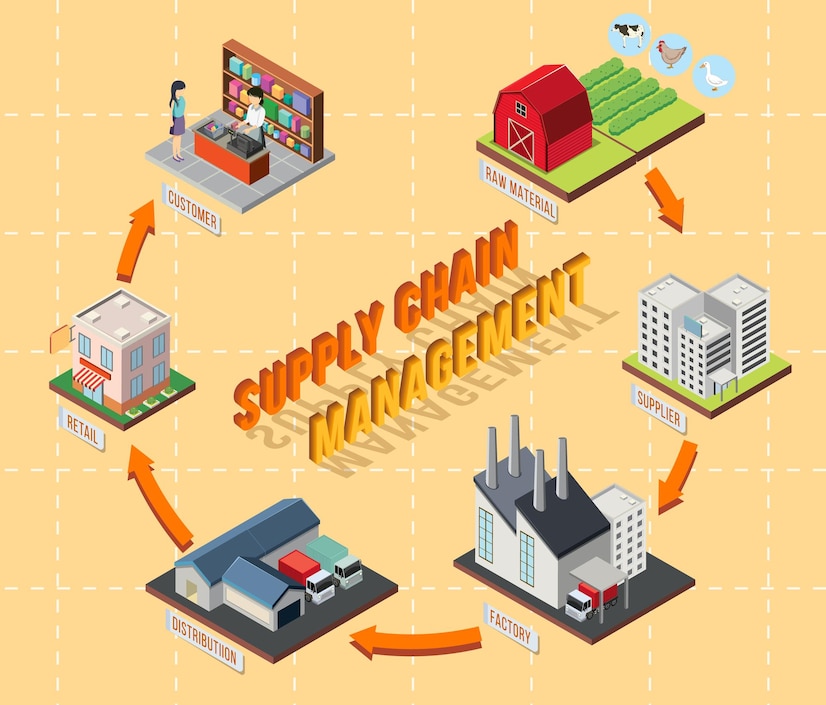
The supply chain is how a company turns raw materials into finished goods and services for the customer. It starts with the harvesting of the raw material. The commodity could be crops, animals, timber, gold, or other natural resources.
The commodity then goes to the manufacturer. That's when it becomes a finished product. There can be several steps in this process and they can involve locations in several different countries.
The finished product goes to one of three places: a wholesaler, a retailer, or directly to the consumer.
How It Affects the Economy
Manufacturing managers decide where to locate the company based on the costs of production. That's led to a lot of jobs outsourcing in technology to India and China. Many call centers have outsourced to India and the Philippines.
If a disaster is bad enough, it can slow global growth. In 2011, Japan's earthquake and the resultant tsunami created the most damage to the world's supply of automobiles, electronics, and semiconductor equipment. The wings, landing gears, and other major airline parts are also made in Japan, so the quake disrupted the production of Boeing's 787 Dreamliner. U.S. gross domestic product slowed in 2011 as 22 Japanese auto part plants suspended production.2
Supply Chain Management
Businesses manage every step of the supply chain to make sure it is the most efficient. As a result, many companies outsource jobs to countries like China that have a lower cost of living.3 East and Southeast Asia accounted for nearly two-thirds of exports from developing countries.4
Many companies vertically integrate to get control of the supply chain. This gives them more control over the production process and costs, which gives the company enough competitive advantage that it is almost a monopoly. But vertical integration is a disadvantage when it restricts flexibility.
How Supply Chain Financing Help Firms Survive
The global credit crisis forced banks and corporations to find innovative ways to raise cash to keep businesses running. Many turned to supply chain financing, which is like a pay-day loan for businesses. Suppliers use the invoice for a shipment as collateral to get a low-interest loan from a bank. Banks know that they will get paid due to the credit-worthiness of the business receiving the goods.
Supply chain financing is especially helpful for small companies. It provides an opportunity to earn better financing terms. Banks were reluctant to lend, even to each other. But they were happy to lend against approved purchase orders and invoices with companies with a good shipping record.
The Bottom Line
Efficient management of the supply chain can reduce costs, maximize customer value, and maximize competitive advantage. It entails effective coordination and control of linked sectors, departments, systems, and organizations. All facilitate the flow of production from conceptualization to point of sale of the product to the consumer.
Corporations that are adept at supply chain management can be more liquid, flexible, and less reliant on banks and middlemen for their cash flows and profits.
What Is an Acquisition?
An acquisition occurs when one company takes control of, or acquires, another existing company.
Definition and Examples of Acquisitions
An acquisition occurs when one company purchases and takes over the operations and assets of another.
The company that purchases another is called the acquiring company, and the company that is bought is the acquired, or target, company.
How Acquisitions Work
Acquisitions can be the amicable result of friendly discussions between two firms in which the target company welcomes the acquisition. In this situation, the two companies negotiate the terms of the acquisition and ultimately reach an agreement.
However, acquisitions can also occur against the will of the acquired firm’s management in what is called a “hostile takeover.” In a hostile takeover, an outside firm acquires a controlling interest in the target firm by purchasing more than 50% of the target company’s shares. This is done by offering the existing shareholders a higher price for their shares than what they could currently get on the open market, thereby enticing them to sell.
Regardless of whether the acquisition is friendly or hostile, the shares of the acquired firm are normally bought for more than their current market value. The difference between the current market price of a share and the price offered through a takeover is called the “premium.”
Types of Acquisitions
An acquisition can be paid for in cash, through a security payment such as a stock-for-stock exchange, a leveraged buyout, or a combination of several of these methods.
A company can acquire another by giving cash to the existing shareholders of the target company for their shares. This is the simplest form of payment.
In a security payment, the acquiring company will offer new securities in exchange for the securities and assets of the target company.3
In a leveraged buyout, the purchasing company borrows a significant amount of the money to complete the transaction, often selling off some of the purchased assets to repay the debt once the deal is complete.
Acquisitions vs. Mergers
The words “acquisition” and “merger” are often used interchangeably in practice, but the two are technically distinct. In an acquisition, the target company is folded into the acquiring company and ceases to exist. In a merger, two firms combine to form a new company.3
|
Merger |
Acquisition |
|
Two companies form a larger one |
One company takes over another |
|
By agreement |
By agreement or hostile |
Pros and Cons of Acquisitions
Acquisitions are motivated by a desire of the acquiring company to improve financial performance. However, as with any business activity, an acquisition is not without risk. There is no guarantee that an acquisition or merger will improve a company’s bottom line.
Pros
Cons
Pros Explained
Cons Explained
Key Takeaways